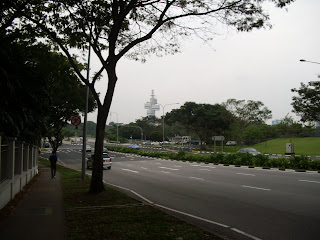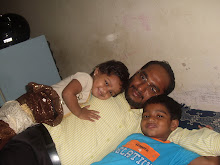
First Experience In MRT
After little rest, I set out with Imam Rafeeq to meet one of his Malayali friends who is also an Imam in a far away mosque. The journey gave me my first experience with the ultra efficient Mass Rapid Transit or MRT rail system, a backbone of Singapore’s public transport system spanning its entire area. Constructed by the Land Transport Authority and run by profit-based corporations SMRT Corporation and SBS Transit, the MRT is the best and easy option to reach most of the places in the city state, with a 3-8 minutes frequency and 5:30am-1am services. The MRT is connected with another Light Rail Transit (LRT) networks as part of the government’s concept of having rail lines that bring people almost directly to their homes.
Most underground stations are deep and hardened enough to withstand conventional aerial bomb attacks and to serve as bomb shelters. The entire system works in a highly sophisticated manner, a clear implementation of all available technologies for the public transport system. Everything is automatic there. You have General Ticketing Machines at every stations and access control gates connected to a computer network, which is capable of reading and updating electronic tickets, storing the entire data including each passenger’s initial and destination stations and the duration for each trip. You can buy an EZ-Link card and recharge it at various outlets when needed, and this can be used for paying for a variety of services. I was using such a card purchased by Rafeeq and Shafeeq to pay for everything from bus-train traveling to taking a photocopy at the self-service xerox machines in the university I visited.
Great Efforts To Keep Singapore Green
What struck me the most when the MRT come out of the underground lines and ran through elevated ones is again the lush, greenish, and flowery surroundings spanning everywhere in Singapore. Coming from Kerala, where the entire greenery is being looted for the benefit of some vested interests, where we are robed of all small and big hills and mountains at our countryside by unbridled new Shylocks supported fully by quotation gangs as well as ‘revolutionaries’, I could only sit amazed seeing great efforts by the Singapore government to transform it to a true garden city.
Before going there, I had a feeling that the life in this city will be hectic and congested. But now I realize this is one of the most beautiful and clean modern metropolises in Asia. Imagine that this same island has more than 36 sq miles of parks, open spaces, nature reserves, roadside greenery, and vacant lands. As part of its advanced planning, it has reserved an additional 16 sq miles for park land when the population reaches 5.5 million people. Thanks to systematic activities of Singapore National Parks Board (NParks), trees are everywhere in this city, and it employs a sophisticated geographic information system (GIS) technology to manage data about and inspect all 1.3 million of trees around.

The NParks conserve, create, sustain and enhance the green infrastructure of the Garden City. Its motto is to provide with an environment that is ‘visually stimulating, physically nourishing and emotionally uplifting’. Other than softening the harshness of the life in a concrete jungle, the NParks also aims at wooing investors through trees and gardens showing potential investors, especially in the initial years that Singapore was an efficient and effective place. Singaporeans give the credit of the luxuriant greenery they enjoys today to its modern father Lee Kuan Yew who showed a strong political will for about 40 years. He passed laws that demanded spaces left for gardens and trees in any new projects, like roads, flats, industries. The newly implemented plans of NParks include creation of a three-dimensional garden for urban environment incorporating landscaped rooftop gardens and other forms of skyrise greenery like planting on parts of the building such as Podium gardens, Facade greenery and Balcony planting.
Asyafa’a; A new Concept Mosque
 Shafa'a: A view from the front
Shafa'a: A view from the front
We walked around 1 km after getting down at the Sembawang MRT to reach the state-of-art modern mosque of Singapore – named Assyafaah. With a sight of the structure from outside, anybody, who is habituated with the typical and stereotyped structures of mosque in mind, would not agree that it is a mosque. But as you learn about this and its activities, including other mosques in Singapore, you understand that Muslims in Singapore, with the help or pressure from the government (it is a debated issue), is working towards creating a community rooted in its mores but exactly suitable for this rapid moving, tech-savvy as well as profit and progress oriented metropolis. Here, you fail looking for domes, the arch, and the minaret - the typical design element from Mughal, Ottoman, Mamluk or Safavid cultures – and I learn that all these were avoided as the new architects made them think that all these have little relevance to the cultural context of Muslims and Malays in Singapore.
Ustad Sharfuddeen from Palakkad district of Kerala is one of the many imams employed by government-controlled Muslim umbrella body called Majlis Ugama Singapua or Islamic Association (MUIS) of Singapore. Ustad Sharafuddeen embraces us and leads to his private room in the mosque. A true Malabari Musliyar (a term Mapilas of Malabar use to call their ulama), Ustad is a man with vast experiences of life having lived in many countries including Malaysia and Madagascar as his interest varies from religious teaching to furniture and horticulture businesses. In Singapore, he served around 10 years, first as an Imam in a small Kampong mosque that was demolished along with 3 other mosques as part of government plans to relocate settlements. Instead of the demolished mosques MUIS constructed Assafa’a at the end of a neighborhood of high-rise residential buildings. I understood there were very limited reactions from Muslims when mosques were demolished, thanks to the efficient and imposing plans of the government employed to cleverly administer its religions through MUIS-like bodies.

Ustad Sharfuddeen takes us around the state-of-the art four-storied multi-purpose mosque, saying it is the first hi-tech mosque built by using the Mosque Building Fund of the MUIS in Singapore. Designed by Singaporean Tan Kok Hiang and Forum Architects, Sssyafa’a's dome-less structure is a deliberate attempt to project a modern face to Islam by ‘creatively re-interpreting the traditional form of the arabesque’. Outside the mosque, there is a ten-story minaret built from ‘rusted steel plates coated with colorless polyurethane’, and you cannot ever compare it with the minarets the mosques in mind.
Ustad Sharafuddin and Imam Rafeeq
We roamed around with the Ustad to see the facilities in the mosque that can accommodate around 5,000 people during the Friday prayers, the only time all the spaces of the mosque utilized for a single purpose, by opening all the doors towards the mihrab and pulpit. The mosque works as a true community centre with Muslim families coming there for everything. It has adopted many family-friendly, Youth-friendly and community-friendly programmes implementing the ‘mosque-is-a-community-centre’ concept. The mosque has 13 hi-tech class rooms for religious learning, successfully utilized to impart Islamic education to children, teenager and adults as well. Around 1200 students learn there and most of the 30 teachers are ladies. It runs a kindergarten also. The entire mosque is connected through32 cameras and CCTVs. There is a multi-purpose hi-tech auditorium, refreshment rooms with all facilities to have tea and snacks, special offices to manage various activities under the mosque and a library.

Active participation of women in religious teaching and learning, in addition to all other activities of the mosque is one of the main characteristics of the entire mosques in Singapore. Taking time out of their office hours, women drive in to the mosque and offer their prayers in the mosque. Posing a question keeping Kerala and other places in mind, Ustad tells me that it has never become a bone of contention in Singapore as most of the women, Muslim or non-Muslim, are working outside home, so it is out of convenience to come to the mosque and have their prayers. Other than the main open prayer hall meant for men, there is a special I’tikaf area (mawqoof as mosque), especially to facilitate for women, and help menstrous women use all other parts of the building during their periods, a time they are exempted from ritual prayers.

Back in his room it was another delicious food with a number of varieties from fish, meat and vegetables. It is amazing to here that a Tamil Muslim women, who runs an average food outlet a kilometer away, walks in everyday with rich and delicious food she prepares, for last eight years, only to get rewards hereafter by feeding the imam of the mosque in time twice a day.
Some Facts On Singaporean Mosques
There are around 68 mosques in Singapore today, all of which are working as a multi-functional institution providing a host of social services, aimed at creation of an excellent Muslim Community. The MUIS-appointed Mosque Management Board (MMB) manages the entire mosques for a 2-year term. Other than officiating the ritual prayers and conducting madrasa classes, mainly aimed at children, mosques in Singapore organizes systematic and structured Family Development courses, Health Talks, Counseling Service and Motivation courses for all strata of the society, youth clubs, Excursions cum Social work, Sports and the co-operation with non-Muslim Youth organizations
In order to meet the needs of relocated Muslim communities, the government supported the Mosque Building Programme of MUIS in 1970s and thus the Syafa’a like new satellite mosques were found near the newly developed residential areas. Old Muslim leaders I met remembered the struggle they first had to get sanctions for new mosques. However, they succeeded in bringing the issue to the notice of then-Prime Minister Lee Kuan Yew, whose intervention facilitated amendments in Administration of Muslim Law Act (AMLA) in 1975 and setting up of the Mosque Building Fund, to which all working Muslims are asked to donate a monthly minimum of S$ 2-5. The amount will be deducted from their salary through a government agency and the government also provides land for the new mosques at nominal prices.

The curriculum and syllabi of the madrasas are well-managed by MUIS, which launched in 2004 a new Mosque Madrasah curriculum called the aL I V E (Living Islamic Values Everyday), notable for a synthesis of the same old content with new approaches, language and assessment mode. The aLIVE is divided into four stages – kids (5-8 year olds), tweens (9-12), teens (13-16) and youth (17-25). There are 35 mosque madrasahs in Singapore and the teachers undergo through special training programme devised by MUIS.




